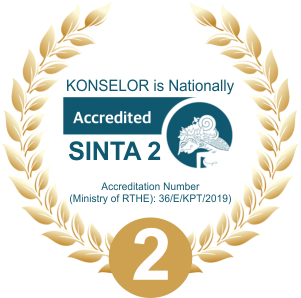The effectiveness of games in group guidance in improving students’ interpersonal relationships
 ),
), (1) Christian State Insitute of Kupang
 Corresponding Author
Corresponding Author
Copyright (c) 2020 Maria Natalia Loban
DOI : https://doi.org/10.24036/0202092108718-0-00
Full Text:
 Language : english
Language : english
Abstract
This research aimed to determine the effectiveness of games in group guidance in improving students' interpersonal relationships. Games that were used were adapted to certain aspects of interpersonal relationships. An experimental method was used in this research, specifically the pre-experimental design: one group pre-test post-test. The effectiveness test was done by comparing the results of pre-test and post-test. The treatments were given to one group only without a comparison group. The hypothesis testing was done using non-parametric statistics, namely the Wilcoxon Statistical Test. The results showed an increase in students' interpersonal relationships through the provision of games in group guidance. The increased interpersonal relationships was by 17.2% and seen in all aspects of interpersonal relationships. Thus, it can be concluded that games in group guidance have proven to be effective in improving students' interpersonal relationships.
Keywords
References
Agusta, A. R. (2018). Improving the Student’s Cooperation and Environmental Care Skill using Outdoor Learning Strategy Outbound Variation. Paper presented at the 1st International Conference on Creativity, Innovation and Technology in Education (IC-CITE 2018).
Ahman. (2011). Konsep Dasar Bimbingan Dan Konseling Perkembangan Dalam Bimbingan Dan Konseling Berbasis Kompetensi. Jakarta: Rajawali Pers.
Arip, M. A. S. M., Bakar, R. B. A., Ahmad, A. B., & Jais, S. M. (2013). The development of a group guidance module for student self-development based on gestalt theory. Procedia-Social and Behavioral Sciences, 84, 1310-1316.
Berscheid, E. S., & Regan, P. C. (2016). The psychology of interpersonal relationships: Psychology Press.
Cattik, M., & Odluyurt, S. (2017). The Effectiveness of the Smart Board-Based Small-Group Graduated Guidance Instruction on Digital Gaming and Observational Learning Skills of Children with Autism Spectrum Disorder. Turkish Online Journal of Educational Technology-TOJET, 16(4), 84-102.
Cavanaugh, A. M., & Buehler, C. (2016). Adolescent loneliness and social anxiety: The role of multiple sources of support. Journal of social and personal relationships, 33(2), 149-170.
Chen, X., Huang, Q., & Davison, R. M. (2017). The role of website quality and social capital in building buyers’ loyalty. International Journal of Information Management, 37(1), 1563-1574.
Chow, C. M., Ruhl, H., & Buhrmester, D. (2013). The mediating role of interpersonal competence between adolescents' empathy and friendship quality: A dyadic approach. Journal of adolescence, 36(1), 191-200.
Corey, G. (2012). Student manual for theory and practice of group counseling: Brooks/Cole, Cengage Learning.
Gelisli, Y., & Yazici, E. (2015). A study into traditional child games played in Konya region in terms of development fields of children. Procedia-Social and Behavioral Sciences, 197, 1859-1865.
Gire, C., Resseguier, N., Brévaut-Malaty, V., Marret, S., Cambonie, G., Souksi-Medioni, I., . . . Tosello, B. (2019). Quality of life of extremely preterm school-age children without major handicap: a cross-sectional observational study. Archives of disease in childhood, 104(4), 333-339.
Guarnieri, S., Smorti, M., & Tani, F. (2015). Attachment relationships and life satisfaction during emerging adulthood. Social Indicators Research, 121(3), 833-847.
Jackson-Dwyer, D. (2013). Interpersonal relationships: Routledge.
Jones, S. M., Barnes, S. P., Bailey, R., & Doolittle, E. J. (2017). Promoting social and emotional competencies in elementary school. The Future of Children, 49-72.
Karimova, L. S. (2015). Prevention of interpersonal conflicts in teenagers’ environment. Procedia-Social and Behavioral Sciences, 191, 1843-1847.
Koçak, C., & Önen, A. S. (2014). The analysis on interpersonal relationship dimensions of secondary school students according to their ruminative thinking skills. Procedia-Social and Behavioral Sciences, 143, 784-787.
Landstedt, E., Hammarström, A., & Winefield, H. (2015). How well do parental and peer relationships in adolescence predict health in adulthood? Scandinavian journal of public health, 43(5), 460-468.
Leon-Perez, J. M., Medina, F. J., Arenas, A., & Munduate, L. (2015). The relationship between interpersonal conflict and workplace bullying. Journal of Managerial Psychology.
Loban, M. N., Wibowo, M. E., & Purwanto, E. (2017). Model Bimbingan Kelompok Menggunakan Games Untuk Meningkatkan Hubungan Interpersonal Siswa. Jurnal Bimbingan Konseling, 6(1), 54-61.
Mahvar, T., Farahani, M. A., & Aryankhesal, A. (2018). Conflict management strategies in coping with students’ disruptive behaviors in the classroom: Systematized review. Journal of Advances in Medical Education & Professionalism, 6(3), 102.
Marlow, S. L., Salas, E., Landon, L. B., & Presnell, B. (2016). Eliciting teamwork with game attributes: A systematic review and research agenda. Computers in Human Behavior, 55, 413-423.
Marzoan, M., & Hamidi, H. (2017). Permainan tradisional sebagai kegiatan ekstrakurikuler untuk meningkatkan kompetensi sosial siswa. Journal An-Nafs: Kajian Penelitian Psikologi, 2(1), 62-82.
Michek, S., & Loudová, I. (2014). Family and interpersonal relationship in early adolescence. Procedia-Social and Behavioral Sciences, 112, 683-692.
Parsons, S. (2015). Learning to work together: designing a multi-user virtual reality game for social collaboration and perspective-taking for children with autism. International Journal of Child-Computer Interaction, 6, 28-38.
Proverbio, A. M. (2017). Sex differences in social cognition: The case of face processing. Journal of neuroscience research, 95(1-2), 222-234.
Rambaran, J. A., Hopmeyer, A., Schwartz, D., Steglich, C., Badaly, D., & Veenstra, R. (2017). Academic functioning and peer influences: A short‐term longitudinal study of network–behavior dynamics in middle adolescence. Child development, 88(2), 523-543.
Snir, S., Gavron, T., Maor, Y., Haim, N., & Sharabany, R. (2020). Friends’ Closeness and Intimacy From Adolescence to Adulthood: Art Captures Implicit Relational Representations in Joint Drawing: A Longitudinal Study. Frontiers in Psychology, 11, 2842.
Tschiesner, R., Tauber, S., Martina, P., & Farneti, A. (2014). Pupils’ Interpersonal Problems And Occupational Stress In Teacher. Preliminary Results. Procedia-Social and Behavioral Sciences, 140, 197-199.
Van Zalk, N., & Van Zalk, M. (2015). The importance of perceived care and connectedness with friends and parents for adolescent social anxiety. Journal of personality, 83(3), 346-360.
Wibowo, M. E. (2005). Konseling Kelompok Perkembangan. Semarang: Unnes Press.
 Article Metrics
Article Metrics
 Abstract Views : 672 times
Abstract Views : 672 times
 PDF Downloaded : 173 times
PDF Downloaded : 173 times
Refbacks
- There are currently no refbacks.
Copyright (c) 2020 Maria Natalia Loban

This work is licensed under a Creative Commons Attribution 4.0 International License.







